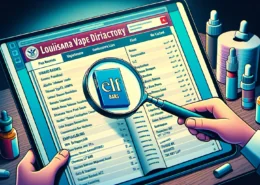Vape Shop Business Plan Template & Guide – 7 Steps to Creating Your Retail Playbook
Starting a vape shop takes careful planning and preparation. A comprehensive business plan serves as the blueprint for building a successful retail vape business. This complete guide provides tips and a customizable template for crafting an effective vape shop business plan. Follow the 7 steps below to document your operations, financials, marketing, and growth strategies.
Step 1: Describe Your Vape Shop’s Purpose and Mission
The first section of your business plan should outline your vape shop’s purpose and mission. Specifically, answer:
- Why are you starting this business? Identify the problems your shop will solve for customers.
- How will you differentiate from competitors? Highlight your unique value proposition.
- What is your long-term vision for the company? Articulate how you want the business to grow and evolve.
Here is an example purpose statement:
“Our vape shop provides a welcoming, upscale environment for vaping enthusiasts to learn about and purchase high-quality devices and e-liquids. Our mission is to help adult smokers transition to the healthier alternative of vaping through education and exceptional service.”
This statement describes the shop’s goals and competitive positioning. Use it as a template to craft your own unique purpose.
Step 2: Detail Your Products and Services Offerings
The next section should provide an overview of your vape product and service offerings by answering:
- What types of vape devices will you carry? Box mods, pod systems, etc.
- What brands and models of devices? A mix of beginner and advanced setups.
- Will you offer imported/exclusive products? Specialty niche devices.
- What range of e-juice flavors and nicotine levels? Fruity, tobacco, dessert, salt nic, etc.
- Will you mix custom flavors on-site? Formulation and blending services.
- What vaping accessories will you stock? Batteries, chargers, wire, wicks, drips tips, etc.
- Will you provide warranties or repairs? Service and support offerings.
- How many product SKUs will you initially carry? Enough selection without overloading.
Make your selections based on target customer preferences and gaps in competition offerings. Update this section as your inventory evolves.
Step 3: Build a Strategic Marketing Plan
A marketing plan is essential for attracting customers and driving sales. Key elements to cover include:
- Defining your target customer demographics like age, gender, location, vaping experience level, etc.
- Analyzing competitors’ positioning, pricing, promotions, strengths and weaknesses.
- Detailing the marketing channels and platforms you’ll leverage such as social media, email, search ads, print, in-store displays, events, etc.
- Crafting branding strategy around logo, store design, packaging, voice, etc.
- Calculating customer acquisition cost and projected lifetime value.
- Planning launch promotions and ongoing campaigns.
- Setting measurable goals and KPIs around traffic, conversions, repeat business, etc.
Continually test and optimize the marketing mix that best resonates with your audience.
Step 4: Document Your Retail Operations Setup
The operations section should cover:
- Real estate – Ideal location, store size, lease terms, layout, signage, etc.
- Registrations and permits – Business license, reseller certificate, age verification protocols, etc.
- Equipment and fixtures – Display cases, counters, POS system, security cameras, etc.
- Inventory – Sourcing, purchasing, receiving, organization, merchandising.
- Staffing – Ideal team size, roles like sales associates, managers, responsibilities, training.
- Policies and procedures – Opening/closing routines, inventory management, loss prevention, etc.
- Safety and compliance – Fire code accommodations, restricted access, MSDS sheets, etc.
Map out every facet of your retail operations from welcoming customers to closing each evening. Adjust plans during build-out as needed.
Step 5: Define Management Structure and Organization
This section explains your vape shop’s management hierarchy and personnel strategy:
- Leadership team – Founders, partners, directors overseeing departments.
- Organization chart – Reporting relationships between leadership, managers, staff.
- Roles and responsibilities – Detail each team member’s duties.
- Staffing strategy – Required skills, experience, culture fit, compensation, incentives, etc.
- Training and development – Onboarding program, ongoing training, performance reviews, etc.
- Communication structure – Daily huddles, weekly team meetings, reporting procedures.
Clarify expectations and decision making authority across the organization. Update org chart as headcount grows.
Step 6: Estimate Startup and Operating Cost Requirements
Accurately projecting startup and ongoing costs is vital for managing cash flow and profitability.
Typical startup expenses include:
- Incorporation, licensing and legal fees
- Lease security deposits and renovations
- Fixtures, displays, decor, signage
- Inventory purchases
- POS system, security equipment, tech
- Marketing collateral and brand assets
- Insurance policies
- Contingency buffer
Ongoing operating expenses consist of:
- Rent and utilities
- Inventory replenishment
- Staff payroll and benefits
- Credit card processing fees
- Website and tech maintenance
- Marketing campaigns and advertising
- Accounting, legal and consulting
- Repairs, maintenance, cleaning
- Bank fees and insurance premiums
Update projections monthly as actual financial data comes in. Only take on essential costs your budget allows.
Step 7: Create a Financial Plan with Sales Forecasts
With costs defined, build out a financial plan projecting profit and growth.
- Sales forecast – Estimate monthly sales based on transaction size, units sold, and customer traffic projections.
- Revenue streams – In addition to product sales, consider services, warranties, advertising, events, etc.
- Gross margin expectations – Given expected COGS, target a healthy markup suitable for your industry.
- Operating expenses – Plug in cost projections from Step 6.
- Profit and loss – Calculate net income accounting for taxes and debt payments.
- Cash flow – Track projected cash coming in vs. going out month-to-month.
- Balance sheet – Assets like inventory and cash reserves vs. liabilities like loans.
- Funding – Define injection of investments, loans and retained earnings.
- Key financial metrics – Break even analysis, ROI, payback period, etc.
Regularly revisit projections and adjust strategies as needed to hit targets.
Bringing It All Together
With each section above completed, your vape shop business plan provides a comprehensive playbook for success. It synthesizes market research, branding, budgeting, operations and financials into one cohesive strategic plan.
Use it to secure financing, align teams, and maintain focus on core goals amid day-to-day distractions. Revisit and revise the plan regularly to keep pace with internal progress and external changes. With careful planning and flawless execution, your vape shop will continually capture market share and thrive.
Frequently Asked Questions
Why is a business plan important for a vape shop?
A business plan is crucial to define your strategy and guide decision making. It helps secure funding, align teams, and maintain focus on your goals. A plan is also required for licensing applications.
What funding options are available to start a vape shop?
Funding can come from personal savings, loans/lines of credit, business partners, private investors, crowdfunding campaigns, and small business grants/loans. Weigh options based on cost of capital and repayment terms.
How much inventory should a new vape shop carry?
Carry enough selection to attract customers but not over-invest in slow-moving items. Limit yourself to 200-500 SKUs initially. Optimize based on sales velocity data over time.
What qualifications and skills make a good vape shop employee?
Look for passion about vaping, strong sales ability, product knowledge, customer service skills, tech aptitude, and cash handling experience. Hire for culture fit.
When should you revise your vape shop business plan?
Revisit your business plan at least quarterly as you execute it. Adjust projections and strategies based on actual performance and market conditions. Use it as an evolving playbook.
- Russia’s Legal Vape Liquid Producers Drop 23-Fold in a Year - July 30, 2025
- Tennessee Vape Shops Confused by New Law’s Rollout - July 30, 2025
- Malaysian Vape Industry Rejects Proposed Ban, Urges Regulation - July 29, 2025









